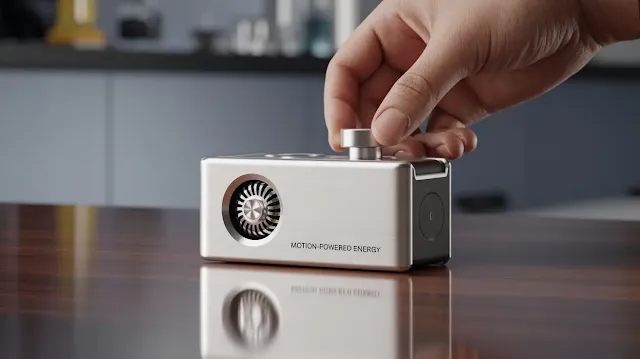Small-Scale Electromagnetic Generators: Motion-Powered Energy in Your Pocket
The Rise of Motion-Driven Energy
In a world increasingly reliant on smart devices and portable electronics, finding sustainable and compact energy solutions has become critical. One groundbreaking innovation leading this change is the miniature electromagnetic generator. These micro-sized devices convert mechanical motion, such as walking, typing, or vibrations, into usable electricity. Often referred to as nano energy generators, they are reshaping how we think about personal and environmental energy harvesting.
How Electromagnetic Nanogenerators Work
The Principle Behind Motion-Powered Energy
At the heart of this innovation lies Faraday’s Law of Electromagnetic Induction, which states that electricity is generated when a conductor moves within a magnetic field. In the case of portable electromagnetic generators, miniature coils and magnets are embedded into wearable or mobile components to convert motion into electrical current in real time.
Combining Energy Systems for Maximum Efficiency
To enhance performance, modern systems integrate electromagnetic generation with other forms of energy conversion, such as triboelectric and piezoelectric methods. This hybrid approach allows devices to capture energy from a wide range of movements and environmental sources, making them highly efficient and versatile.
Key Innovations in Portable Generator Technology
Wearable-Powered Electronics
Recent prototypes have been embedded in wearable items such as backpacks or shoes. These generators produce electricity from the natural movement of the human body, powering low-energy devices like LED lights, step counters, or medical sensors.
Rotary-Based Microgenerators
Another development involves rotary microgenerators, which utilize spinning or oscillating motion (e.g., from wrists or ankles) to produce consistent energy output. These compact modules have shown significant promise in wearable health trackers and fitness devices.
Applications of Nano-Scale Power Generation
Powering Smart Wearables
By integrating nano-scale power generators into clothing or accessories, manufacturers can eliminate the need for traditional batteries in wearables. These systems can power heart rate monitors, step counters, GPS trackers, and temperature sensors through movement alone.
Enabling Self-Sufficient IoT Devices
For Internet of Things (IoT) systems, especially in remote or hard-to-reach locations, electromagnetic nanogenerators provide an autonomous energy solution. Devices can function longer and more reliably without external power supplies, benefiting industries like agriculture, infrastructure, and smart cities.
Supporting Environmental Monitoring
Tiny energy harvesters placed on bridges, roads, or industrial machinery can convert environmental vibrations into energy, powering sensors that track stress, weather changes, or mechanical wear, helping reduce infrastructure maintenance costs and improve public safety.
Advantages of Electromagnetic Microgenerators
Sustainable and Clean Energy: They reduce reliance on disposable batteries and lower electronic waste.Compact and Lightweight: Ideal for integration into mobile or wearable technologies.
Cost-Effective Operation: Once installed, they generate power without additional fuel or energy input.
Scalable Use: Can be customized for everything from personal devices to large-scale monitoring systems.
Challenges and Limitations to Overcome
Limited Power Output
Despite their potential, most nano generators currently produce low levels of electricity—suitable for small sensors or LEDs, but not yet ideal for high-power applications like smartphones.
Durability and Longevity
Because these generators are subject to repeated motion and physical stress, developing materials that remain effective over long periods is essential for their long-term viability.
Integration Complexity
Merging multiple energy-harvesting systems (EMG, TENG, PENG) into a unified circuit poses challenges in terms of circuit design, energy storage, and cost management.
The Future of Nano Power Technologies
Advancements in Material Science
The use of flexible, durable materials like graphene, carbon nanotubes, and advanced polymers is enabling more resilient and efficient energy harvesting components. These materials also allow integration into fabric, plastic, and flexible surfaces.
Smart Energy Management Systems
Intelligent microcontrollers and software now help manage energy flow, optimize charging cycles, and store surplus electricity. This is key for making mini electromagnetic generators a practical alternative in commercial products.
Biocompatible Power for Healthcare Devices
Future applications may involve powering implantable or skin-mounted health monitors using the patient's own motion. These ultra-miniaturized systems promise safer and more convenient medical diagnostics and drug delivery methods.
Real-World Case Study Highlights
Wearable Backpack Generator: A hybrid electromagnetic and triboelectric generator placed in a backpack harvested energy from walking and produced enough power to illuminate small LED lights.Rotary Shoe Generator: Developed to harness rotational movement from ankle swings, this device generated sufficient electricity to charge low-power wearable sensors.
Structural Health Monitoring: Installed on bridges, miniature electromagnetic harvesters collected energy from vehicle-induced vibrations to power crack-detection sensors.
Conclusion: Powering the Future with Every Step
Miniature electromagnetic generators represent a pivotal step in making energy harvesting a seamless part of daily life. As these devices evolve, they offer a future where wearable tech, smart infrastructure, and remote sensors are no longer bound by battery limitations.
From fitness wearables and smartwatches to industrial IoT systems and environmental monitors, the potential applications are vast. As innovation continues, we may soon carry personal energy sources in our pockets, powering the world with nothing more than motion.




Write a comment, your opinion matters to us